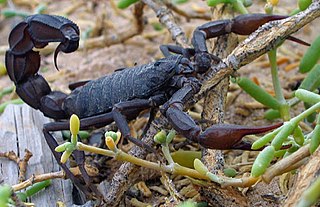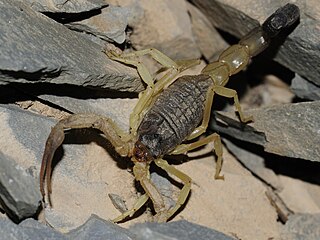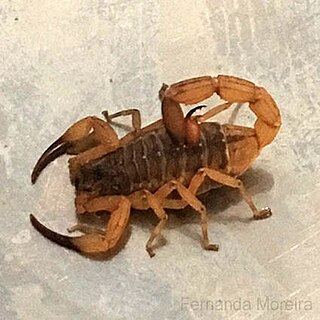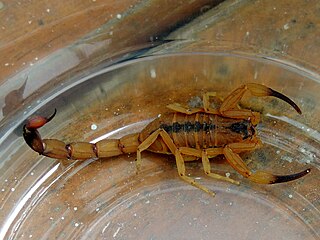
Phoneutria is a genus of spiders in the family Ctenidae. They are mainly found in northern South America, with one species in Central America. Members of the genus are commonly referred to as Brazilian wandering spiders. Other English names include armed spiders and banana spiders.

The Arizona bark scorpion is a small light brown scorpion common to the Sonoran Desert in the southwestern United States and northwestern Mexico. An adult male can reach 8 cm in length (3.14 inches), while a female is slightly smaller, with a maximum length of 7 cm (2.75 inches).

Weevers are nine extant species of fishes of family Trachinidae, order Trachiniformes, part of the Percomorpha clade. They are long, mainly brown in color, and have venomous spines on their first dorsal fin and gills. During the day, weevers bury themselves in sand, just showing their eyes, and snatch prey as it comes past, which consists of shrimp and small fish.

Fattail scorpion or fat-tailed scorpion is the common name given to scorpions of the genus Androctonus, one of the most dangerous groups of scorpion species in the world. The genus was first described in 1828 by Christian Gottfried Ehrenberg.

Centruroides bicolor is a species of bark scorpion from Central America. Its specific name "bicolor" is from the Latin meaning "two colored" and refers to the markings of this species.

A scorpion sting is an injury caused by the stinger of a scorpion resulting in the medical condition known as scorpionism, which may vary in severity. The anatomical part of the scorpion that delivers the sting is called a "telson". In typical cases, scorpion stings usually result in pain, paresthesia, and variable swelling. In serious cases, scorpion stings may involve the envenomation of humans by toxic scorpions, which may result in extreme pain, serious illness, or even death depending on the toxicity of the venom.

Hottentotta is a genus of scorpions of the family Buthidae. It is distributed widely across Africa, except for most of the Sahara desert. Species in the genus also occur in the Middle East, the Arabian Peninsula, southeastern Turkey, Iraq, Iran, Afghanistan, Pakistan, India, Nepal, Cape Verde Islands, and Sri Lanka (introduced).

Hottentotta tamulus, the Indian red scorpion, also known as the eastern Indian scorpion, is a species of scorpion of the family Buthidae. It occurs in most of India, eastern Pakistan and the eastern lowlands of Nepal, and recently from Sri Lanka.

Many species of arthropods can bite or sting human beings. These bites and stings generally occur as a defense mechanism or during normal arthropod feeding. While most cases cause self-limited irritation, medically relevant complications include envenomation, allergic reactions, and transmission of vector-borne diseases.

Tityus serrulatus, the Brazilian yellow scorpion, is a species of scorpion of the family Buthidae. It is native to Brazil, and its venom is extremely toxic. It is the most dangerous scorpion in South America and is responsible for the most fatal cases.

Tityus stigmurus is a species of scorpion from the family Buthidae that can be found in Brazil. The species are 4.5–6 centimetres (1.8–2.4 in) in length and are either golden-tan or yellowish-brown coloured. It takes them a year to mature into an adult, which makes them a fast-growing species. They also have a dark stripe over the mesosoma with either yellowish or orange pedipalps.

Chiropsalmus quadrumanus, commonly known as the four-handed box jellyfish, is a species of box jellyfish found in the western Atlantic Ocean, the Gulf of Mexico and the Pacific Ocean. The sting is venomous and dangerous to humans, especially children.
Centruroides baergi is a species of scorpion in the family Buthidae. They are commonly found in highlands and are almost exclusively found in the states of Oaxaca and southern Puebla, Mexico. C. baergi is the most abundant scorpion of the genus in the state of Oaxaca, making up a third of Centruroides reported between 2008 and 2014.

Onychocerus albitarsis is a relatively rare species of beetle in the family Cerambycidae from the Amazon and Atlantic forest regions in Brazil, Bolivia, Paraguay and southern Peru. It is remarkable for being the only known beetle that has a venomous sting and the only known arthropod that stings with its antennae. Each antenna ends in a stinger that has evolved to resemble a scorpion's tail and it is connected to a venom gland. The sting was already reported in 1884 but researchers thought the pain only was caused by the sharpness of the antennae, as also known from some other beetles. It was only confirmed in 2005 that it is venomous when a biologist was stung, comparing it to a bee sting, and subsequently studied it in detail. In the first of two other cases where the identity of the stinging insect was confirmed to be this beetle, a woman experienced significant pain directly after the incident, and redness and itching at the sting site that lasted for a week. In the other case a man experienced moderate pain directly after being stung and redness that only lasted for an hour. The other species in the genus Onychocerus appear to not be venomous since they lack the structures inside the antennae that are associated with the venom apparatus of Onychocerus albitarsis.
Limbatustoxin, is an ion channel toxin from the venom of the Centruroides limbatus scorpion. This toxin is a selective blocker of BK channels, calcium-activated potassium channels.

Leiurus abdullahbayrami is a species of scorpion in the family Buthidae. Its venom is highly toxic to humans, but can be used in medical development.

Scorpionism is defined as the accidental envenomation of humans by toxic scorpions. If the injection of venom in a human results in death, this is defined as scorpionism. This is seen all over the world but is predominantly seen in the tropical and subtropical areas. These areas include Mexico, northern South America and southeast Brazil in the Western hemisphere. In the Eastern hemisphere, scorpionism possess a public health threat in the regions of South Africa, the Middle East, and the Indian subcontinent.

Snakebite envenomation is considered a public health problem in Latin America, with an estimated 70,000 cases annually, but due to underreporting, these numbers may be even higher.

Tityus pachyurus is a species of arachnid endemic to Central America and South America.

List of reported attacks and species involved in Latin America.

















